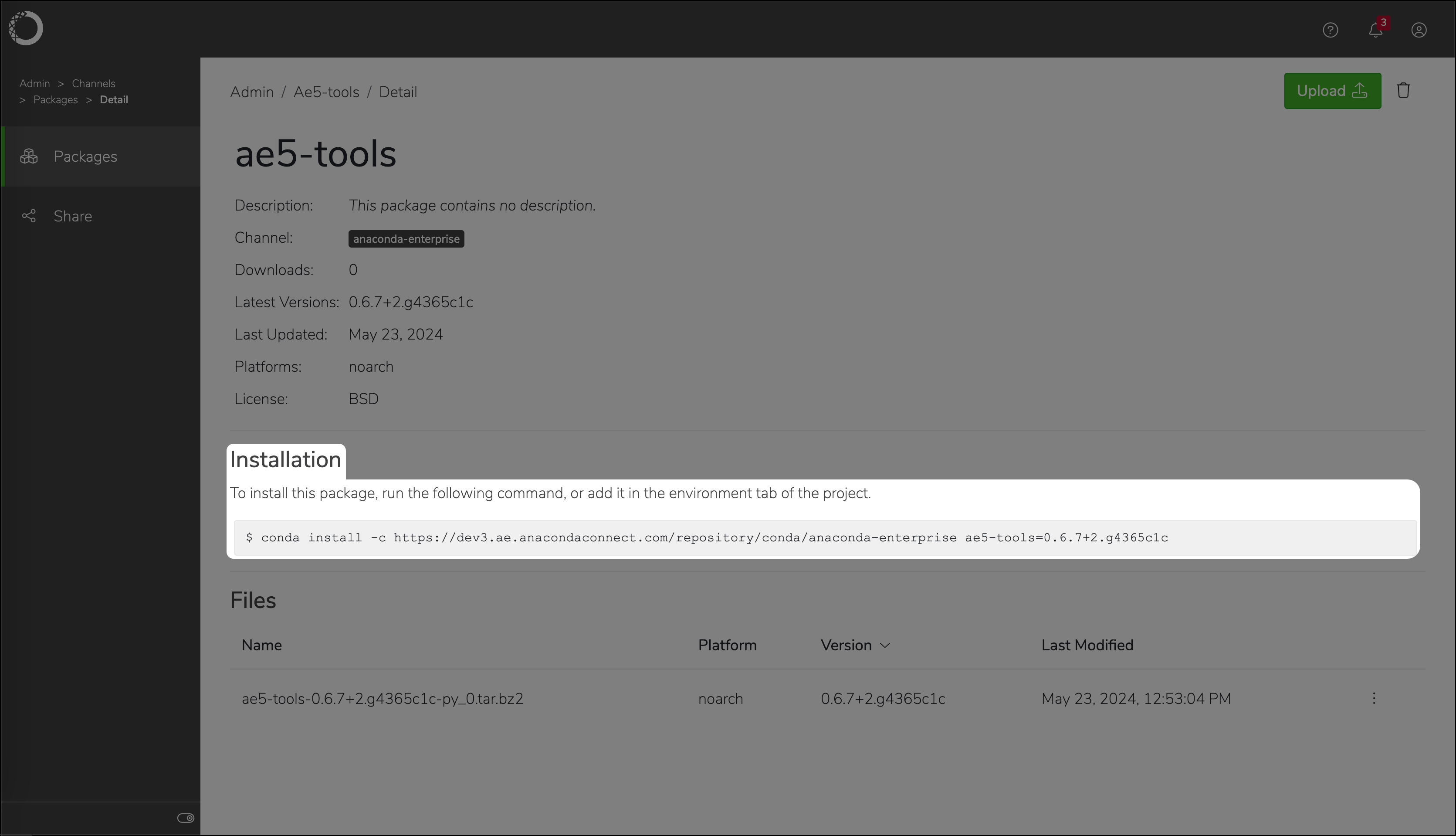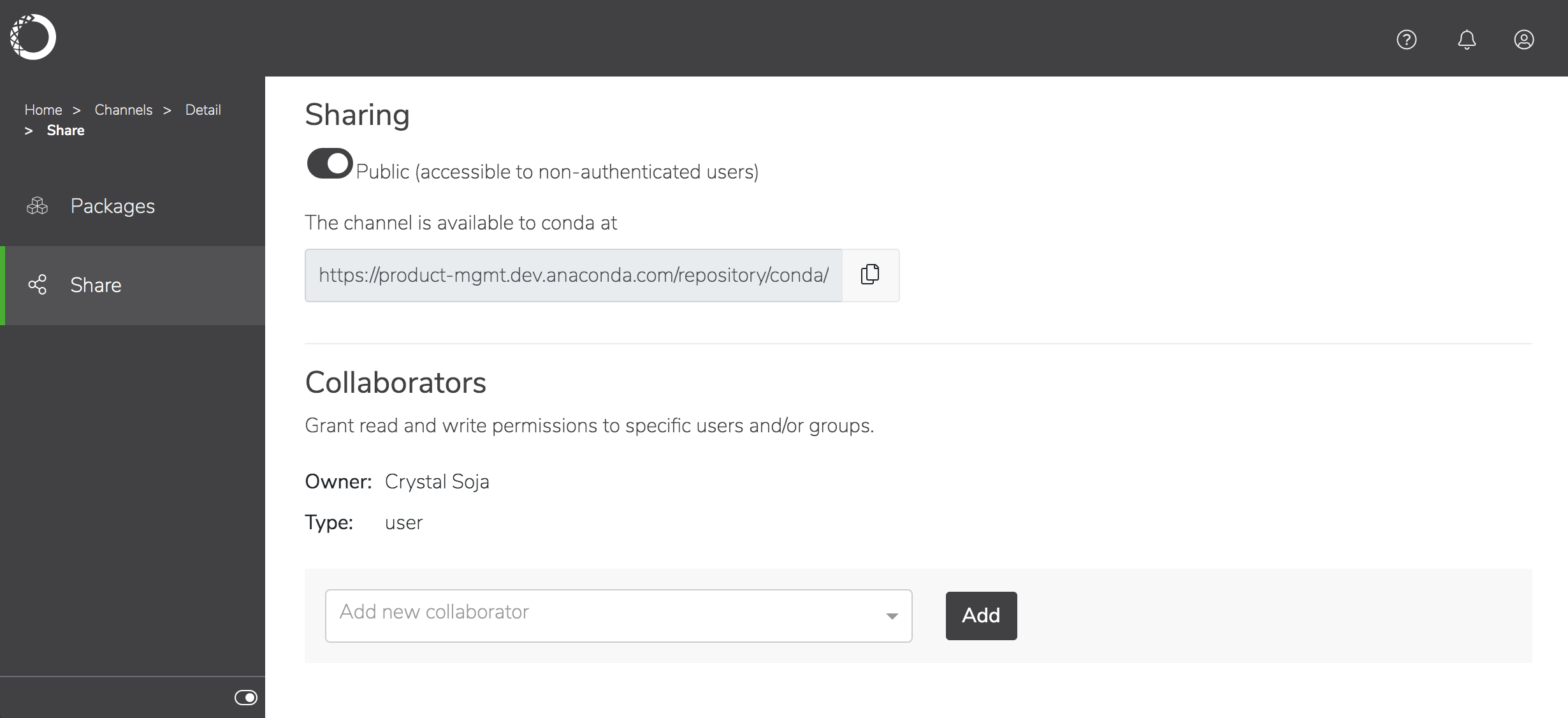Managing channels and packages#
Data Science & AI Workbench allows all users to create channels in the internal Workbench repository and allows users with the ae-uploader role to upload packages to channels that they have read-write permissions for.
Note
For more information about assigning user permissions, see roles.
For more information about channel permissions, see sharing channels.
For more information about how Workbench manages channels, see configuring conda in Workbench.
As an administrator, it is your responsibility to monitor and maintain the channels and packages that are available in the internal Workbench repository for your users.
Warning
Do not modify the anaconda-enterprise channel. Modifications to this channel can cause serious problems for the platform!
Viewing all channels#
As an administrator, you are able to view and manage all channels.
Log in to Workbench as a user with administrator permissions.
Tip
The
anaconda-enterpriseuser has the correct permissions.Open the My Account dropdown menu and select Admin Console.
Select Channels from the left-hand menu.
The channels page displays a complete list of channels that exist within the internal Workbench repository. Each channel’s owner and when the channel was last updated is displayed for all channels.
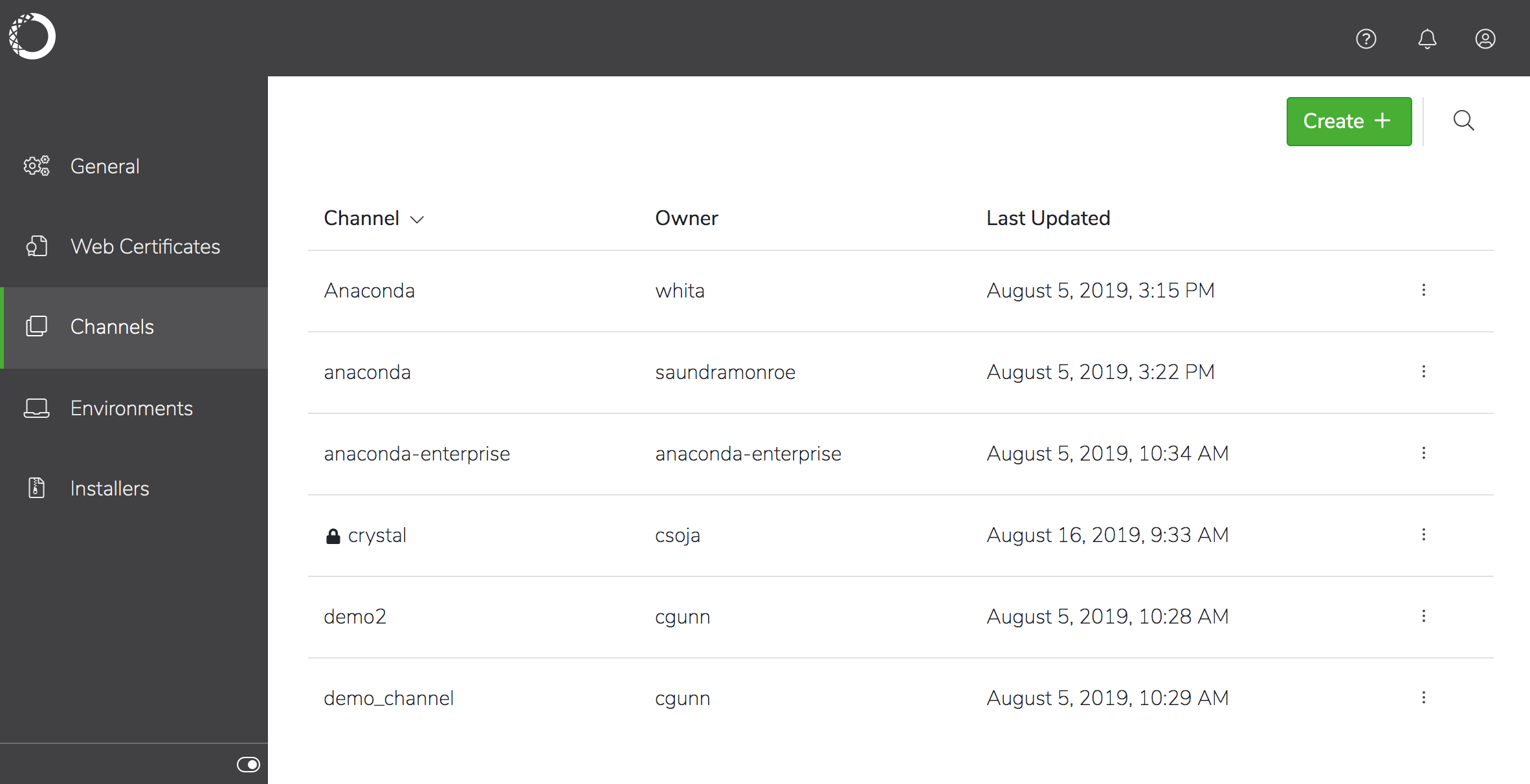
Note
Channels that display a lock beside their name are private. For more information about private channels, see sharing channels.
Creating a channel#
To create a channel in the internal Workbench repository:
Log in to Workbench.
Select Channels from the left-hand menu.
Click Create in the upper right corner.
Set the channel to public or private access.
Enter a name for the channel, then click Create.
Viewing channel packages#
From the channels page, click on a channel name to view its packages.
You can see the supported platforms, latest versions, when each package in the channel was last modified, and the number of times each package has been downloaded.
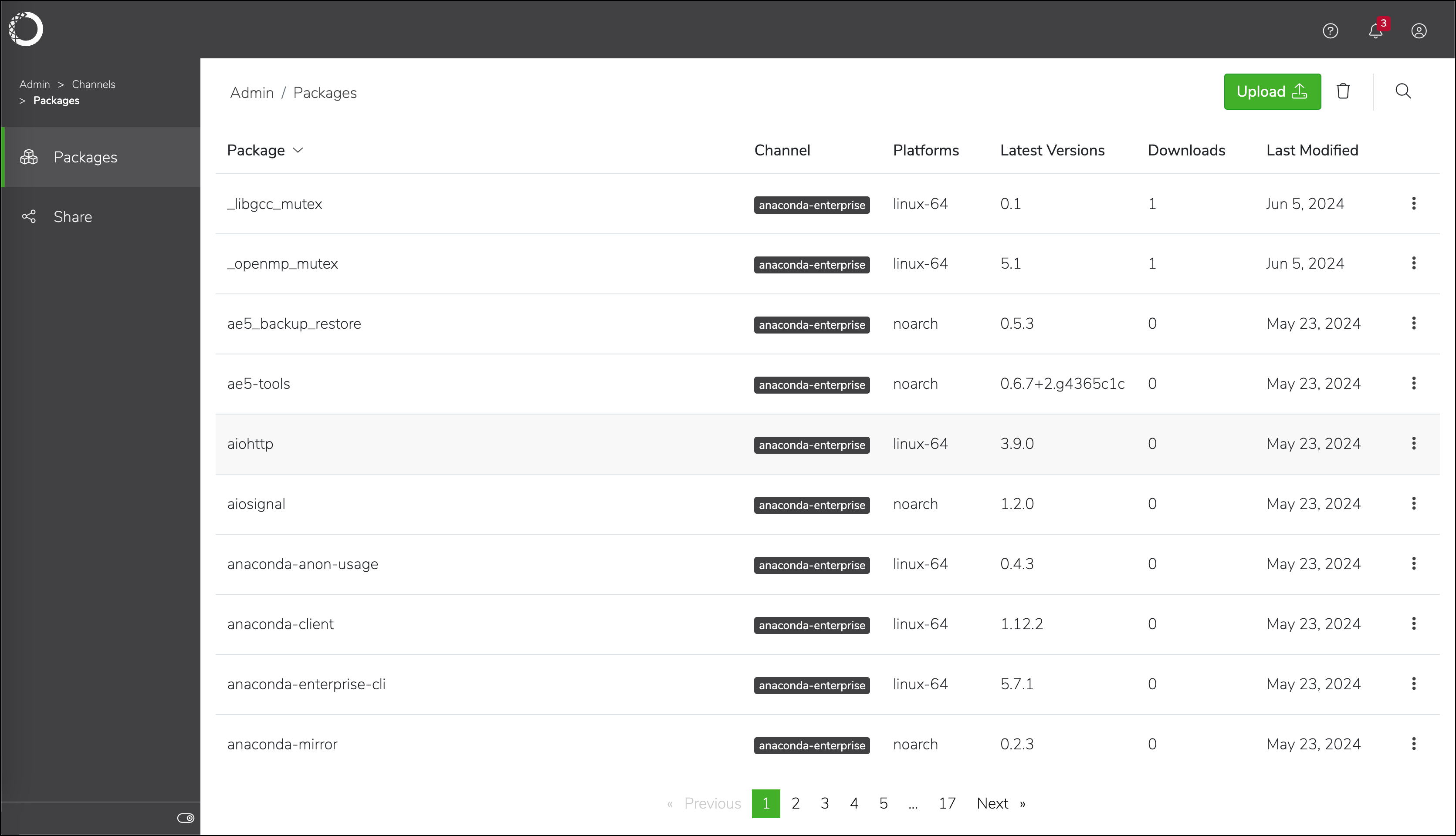
Viewing package details#
Each package in Workbench presents valuable information pertaining to the package, such as its platform architecture, version, license, number of downloads, and the last time the package was updated. You can also find a command on this page to assist you with installing the package in your environment.
From the channel packages page, select any package to view the package details page.
Tip
You can search for packages by name to locate them more efficiently.
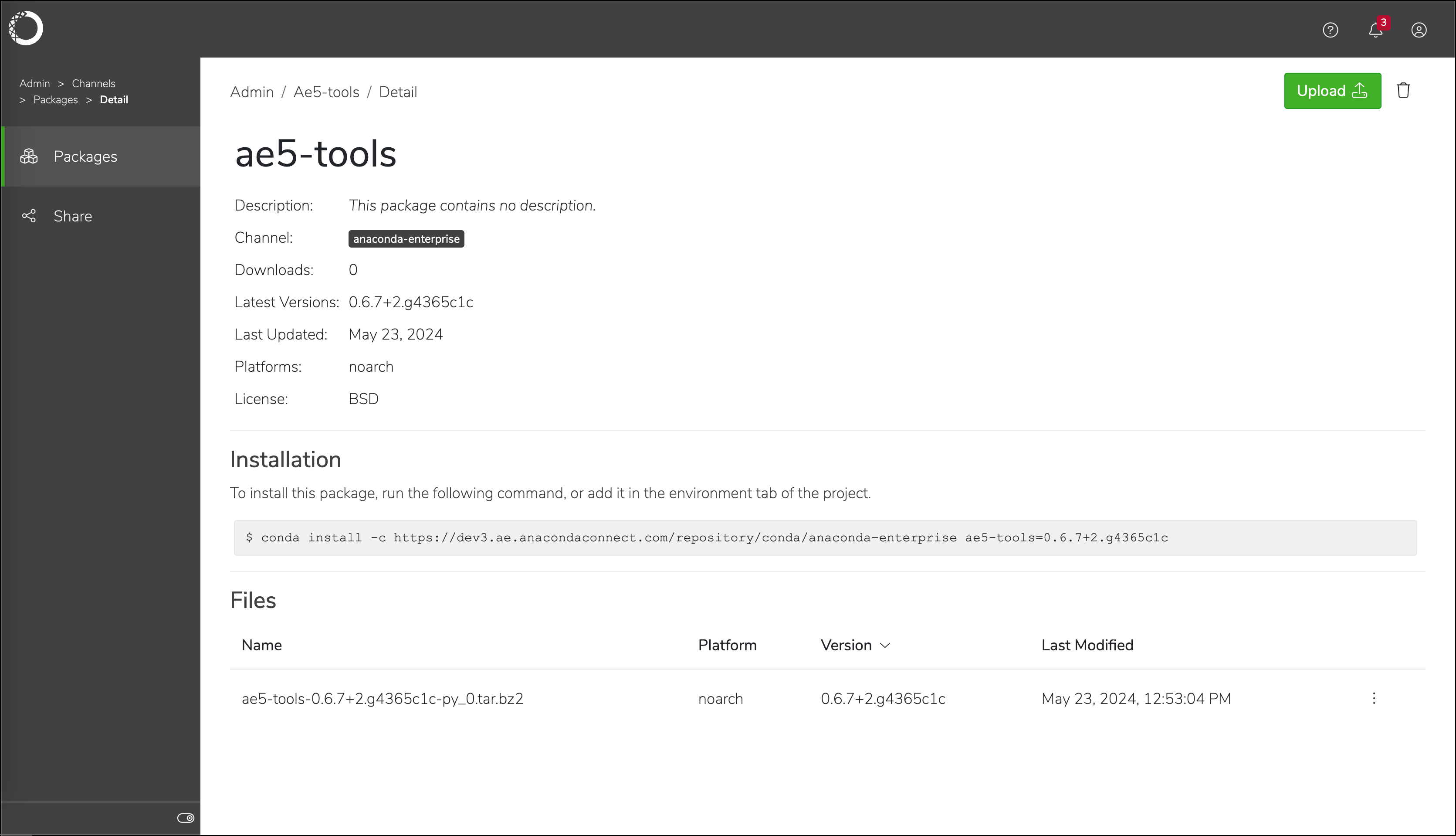
Uploading a package to a channel#
To add a package to an existing channel:
From the channels page, click on a channel name to view its packages.
Click Upload .
Click Browse and locate the package in your file system.
Click Upload.
Note
There is a 1GB file size limit for package file uploads.
Installing a package from a channel#
To install a package from an internal Workbench channel:
From the channels page, click on a channel name to view its packages.
Select any package to view the package details page.
Copy the installation command provided.
Run the copied command in the environment you want to install the package in.
Removing a package from a channel#
To remove a package from an internal Workbench channel:
From the channels page, click on a channel name to view its packages.
Open the package’s actions dropdown menu, then select Delete.
Click Delete.
Managing channels using the CLI#
Log in to the CLI before you begin attempting to manage channels.
Creating a channel#
Create a new channel in the internal Workbench repository by running the following command:
# Replace <CHANNEL_NAME> with the name of the channel you want to create
anaconda-enterprise-cli channels create <CHANNEL_NAME>
Uploading a package to a channel#
Upload a conda package to a channel by running the following command:
anaconda-enterprise-cli upload --channel <path/to/package>
Listing all channels#
Get a list of all the channels on the platform with the channels list command:
anaconda-enterprise-cli channels list
Sharing channels#
Share and manage permissions for channels with the share command:
# Replace <CHANNEL_NAME> with the name of the channel you want to share
# Replace <USERNAME> with the username of the user you want to share the channel with
anaconda-enterprise-cli channels share --user <USERNAME> <CHANNEL_NAME>
# Replace <CHANNEL_NAME> with the name of the channel you want to share
# Replace <GROUP_NAME> with the name of group you want to share with
anaconda-enterprise-cli channels share --group <GROUP_NAME> <CHANNEL_NAME>
Note
By default, sharing a channel with a user or group provides them with read-write access to the channel. Restrict access to the channel to read-only by including --level r before the <CHANNEL_NAME>.
For example:
anaconda-enterprise-cli channels share --group <GROUP_NAME> --level r <CHANNEL_NAME>
Revoking channel access#
Revoke a user’s or a group’s access to a channel by running one of the following commands:
# Replace <CHANNEL_NAME> with the name of the channel you want to revoke access to
# Replace <USERNAME> with the username of the user whose access you want to revoke
anaconda-enterprise-cli channels share --user <USERNAME> --remove <CHANNEL_NAME>
# Replace <CHANNEL_NAME> with the name of the channel you want to revoke access to
# Replace <GROUP_NAME> with the name of the group whose access you want to revoke
anaconda-enterprise-cli channels share --group <GROUP_NAME> --remove <CHANNEL_NAME>
Setting a default channel#
The default_channel value is not set when anaconda-enterprise-cli is installed. This means every time you run an upload command, you need to supply a specific channel name.
If you don’t want to include the --channel option with each command, set a default channel by running the following command:
# Replace <CHANNEL_NAME> with the name of the channel you want to upload to by default anaconda-enterprise-cli config set default_channel <CHANNEL_NAME>
View your current default channel by running the following command:
# Replace <CHANNEL_NAME> with the name of the channel you want to upload to by default anaconda-enterprise-cli config get default_channel '<CHANNEL_NAME>'
Note
For more information about actions you can take with channels in the CLI, run the following command:
anaconda-enterprise-cli channels --help
